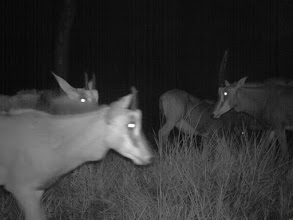Read Biologist Pedro Vaz Pinto’s 2020 Report with photos, in English and Portuguese, now on our Giant Sable page.

Due to the global pandemic, field activities have been severely constrained and for several months Pedro could not travel to the giant sable areas, but having several sables carrying GPS satellite collars made it possible for him to track them remotely from home daily and keep “a sort of ethereal link with the animals in the bush”. Meanwhile the rangers were always able to continue their routine work. Early in October 2020, Pedro was finally able to track the sables on the ground.

“The extraordinary events of 2020 are also threatening to take a huge toll on the giant sable conservation, which may be nefariously affected in different ways. Most notably, there is an immediate contraction in economic activity which has caused some of our more reliable and long-lasting donors operating in Angola, to announce that they may not renew their contributions and even previously agreed commitments have been put on hold. But possibly even more worryingly, the economic strangulation is obviously much increasing the strain on people’s livelihoods, which in turn makes the prospect of adopting illegal activities such as poaching, more attractive and in some cases unavoidable. Sure enough, an increased poaching pressure has already been felt and is a major cause of concern these days.”




In Cangandala Park the giant sables are contained inside the 4,400 ha fenced camp and at least are reasonably well protected. Interestingly, “unlike the previous breeding season when we observed one very large herd concentrated together and comprising of the majority of the female stock and including most bulls orbiting around them, on this occasion it appears that the females were dispersed into smaller-sized groups, and each dominated by a single bull.”



In Luando, the hope was to assess the condition of the five herds by filming them with drones – view videos at this link. Thankfully rains had not yet arrived steadily in Luando.
A representation of insect diversity in Cangandala and Luando Reserve:
Visit our Giant Sable page to read Pedro Vaz Pinto’s full report.



















































